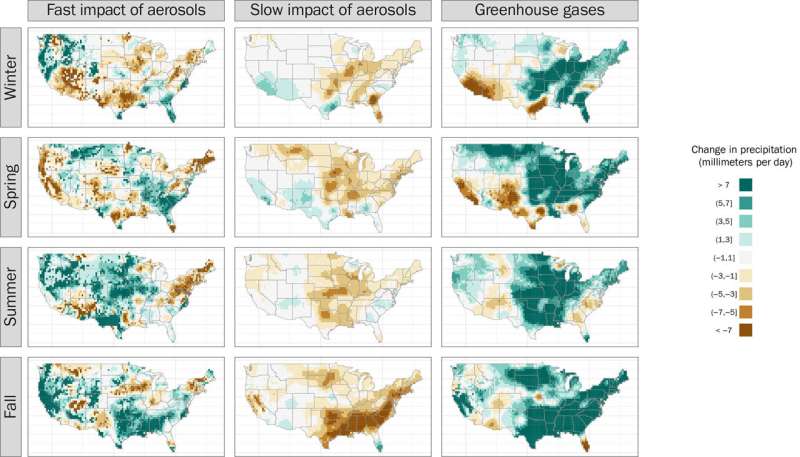This article has been reviewed according to Science X's editorial process and policies. Editors have highlighted the following attributes while ensuring the content's credibility:
fact-checked
peer-reviewed publication
trusted source
proofread
Research shows how air pollution has offset expected increases in rainfall

We know that greenhouse gas emissions like carbon dioxide should increase rainfall. The emissions heat the atmosphere, causing a one-two punch: Warmer oceans make it easier for water to evaporate, and warmer air can hold more water vapor, meaning more moisture is available to fall as rain. But for much of the 20th century, that increase in precipitation didn't clearly show up in the data.
A new study led by researchers at the Department of Energy's Lawrence Berkeley National Laboratory (Berkeley Lab) finds that the expected increase in rain has been largely offset by the drying effect of aerosols—emissions like sulfur dioxide that are produced by burning fossil fuels, and commonly thought of as air pollution or smog. The research is published in the journal Nature Communications.
"This is the first time that we can really understand what's causing extreme rainfall to change within the continental U.S.," said Mark Risser, a research scientist at Berkeley Lab and one of the lead authors for the study. He noted that until the 1970s, the expected increases to extreme rainfall were offset by aerosols. But the Clean Air Act caused a drastic reduction in air pollution in the United States. "The aerosol masking was turned off quite suddenly. That means rainfall might ramp up much more quickly than we would have otherwise predicted."
Traditional climate models have struggled to confidently predict the human impact on rainfall at scales smaller than a continent—and that regional level is precisely where most climate change adaptations and mitigations take place. By using a new method and relying heavily on measurements from rain gauges from 1900 to 2020, researchers were able to more robustly determine how human activities have influenced rainfall in the United States.
"Prior to our study, the Intergovernmental Panel on Climate Change [IPCC] had concluded that the evidence was mixed and inconclusive for changes in U.S. precipitation due to global warming," said Bill Collins, associate laboratory director for the Earth and Environmental Sciences Area at Berkeley Lab and co-lead author on the study. "We have now provided conclusive evidence for higher rainfall and also helped explain why past studies assessed by the IPCC reached conflicting conclusions."
Specifically, the study isolates how greenhouse gas and aerosol emissions affect both average and extreme rainfall. Researchers confirmed that increased greenhouse gas emissions, which quickly disperse over the whole planet, cause an increase in rainfall. The impact from aerosols is more nuanced. Over the long term, aerosols cool the planet, which causes a drying effect. But they also have a faster, more local response. That fast impact depends on the season, with aerosols generally reducing rainfall in the winter and spring, and amplifying it in summer and fall over much of the United States.
"The seasonality piece is really important," Risser said. "For rainfall, the nature of climate change depends on what season you're talking about, since different kinds of weather systems create precipitation in different parts of the year."
Some of the conflicting studies looking at precipitation trends of the last century can be explained by how the effect of aerosols offsets the effect of greenhouse gases, and how models and simulations factor in these two driving forces. The researchers noted that tracking aerosols and incorporating them more fully into models and simulations will be important for improving the predictions used for infrastructure design and water resource management.
The United States has already seen examples of recent increases in extreme precipitation, with several intense, record-setting storms in the past few years.
"Thanks to improvements in air quality, the aerosols that shielded us from the worst effects of global warming are declining worldwide," Collins said. "Our work shows that the increases in extreme precipitation driven by elevated ocean temperatures will become increasingly obvious during this decade."
More information: Nature Communications (2024). DOI: 10.1038/s41467-024-45504-8. www.nature.com/articles/s41467-024-45504-8
Journal information: Nature Communications
Provided by Lawrence Berkeley National Laboratory





















